Yeovil People
Theodore Neal & Charles Williams
Ironmongers and Builders' Merchants
Many Yeovilians will remember the ironmongers and builders' merchants Neil & Williams that traded in Yeovil until the early 1970s. The company was founded in 1891 by Theodore Neal, a Yeovil ironmonger originally from Wiltshire, and Charles Williams, originally from Devon - however few people today realise that their joint enterprise was actually taken over in 1896.
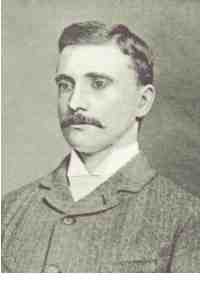 Theodore
Neal
Theodore
Neal
Theodore Neal was born in 1860 at Sherston Magna, Wiltshire, the son of house painter Henry Neal (1825-1885) and his wife Elizabeth Margaret née Weight (1823-1917). In the 1861 census Henry and Elizabeth, together with their children Ada (b 1849), Alma (b 1856), Henry Herbert (b 1858) and one-year old Theodore were living in a house in High Street, Sherston Magna, they shared with three other families. By the time of the 1881 census Theodore was boarding with ironmonger George Lloyd and his family in Salisbury, Wiltshire. Theodore was one of five ironmonger's apprentices living with George Lloyd.
In the autumn of 1888 Theodore married Rose Louisa Morris at Richmond, Surrey, but by 31 August 1888 Theodore had taken over the ironmongery business of Cox & Son (which failed due to debt) with premises in both 28 Middle Street and 20 Vicarage Street. He was listed as an ironmonger twice in Whitby's Yeovil Almanack Advertiser of 1889.
|
In the 1891 edition of 'Where to Buy' Theodore Neal's business was given the following description -
Mr T
Neal,
The ramifications of the ironmonger's business are so great, and the consequent amount of technical knowledge required by the practical general ironmonger is so vast, that it is impossible to achieve success in a business of this sort unless the proprietor be thoroughly acquainted with every detail. The wholesale and retail ironmongery emporium of Mr T Neal, is situated at the corner of Middle and Vicarage Streets. The business was established some thirty years ago, by Mr Ostler, and the present proprietor succeeded to the concern about four years since. In the show rooms we noticed ranges, oil and gas stoves, register and encaustic tile grates, etc., arranged in symmetrical order. The display of duplex and round wick lamps, of beautiful designs and efficient lighting powers, is of a nature to meet the requirements of all. This is a noted house for cutlery, the stock of table and pocket goods being obtained from the first Sheffield houses. Mr Neal holds a complete stock of locks, and will fit you out with a Chubb or Bramah door, chest, till, or desk lock, a dainty detector brass pad, or a heavy, serviceable galvanised iron one, a mortice lock for the drawing room, or a plate one for the barn door. Tools of all kinds for masons, locksmiths, carpenters, wheelwrights, painters, builders, etc., also garden and agricultural tools and implements, of the highest grade and in every variety, are a speciality. Hollow ware of all kinds, tin goods of every description, trunks in great variety, baths of all sizes and descriptions are here for selection. Mr Neal has a fine collection of electro-plated goods of sound make and elegant design. His stock of brushes and oil cloth is very extensive and of an exceptional quality. A capital show of perambulators and mail carts, of the most recent designs, is maintained. Every description of builders' ironmongery is supplied, and the stock of bedsteads and furnishing ironmongery is a most exhaustive one. Mr Neal is agent for the Fire Harden Star Hand Grenade, and also supplies all kinds of ammunition. The proprietor purchases direct from the manufacturers, and thus is enabled to offer his customers distinct advantages. Intending purchasers would do well to send for one of Mr Neal's illustrated catalogues, when any orders entrusted to his care will receive prompt attention.
|
In the 1891 census Theodore and Rose were living at 12 The Park with their 9-month old daughter Gladys Weight, his mother and sister Alma (both widows) and a general domestic servant. He was listed as an ironmonger.
Theodore was a Freemason and was initiated into Yeovil's Lodge of Brotherly Love on 28 June 1893. He served as Worshipful Master of the Lodge in 1902.
By the time of the 1901 census Theodore and Rose were living at 135 Sherborne Road with daughter Kathleen May (b 1894), son William Francis Ring, known as Willie, (b 1896), his mother Elizabeth and a domestic servant. Next door, at 133, lived his sister Alma Lamb.
Although Neal & Williams Ltd maintained a presence in Yeovil, by 1911 Theodore had moved his family to Burgess Hill, Clayton, Sussex. The 1911 census listed him as 'Ironmonger (Dealer)'. He and Rose were living with their three children; Gladys, Kathleen and William, with the latter two occupied as 'assisting in Business'.
Theodore Neal died in 1942 at the Wirral, Cheshire. He was aged 82.
Charles Williams
Charles Williams was born in 1860 at Uffculme, Devon, the son of 43-year old retired druggist Charles Williams Snr (b1818) and his 25-year old wife Jane (b1836), originally from Bath. In the 1861 census the family were living in Prospect Place, Uffculme. By 1871 the family had moved to College Court, Uffculme, at which time Charles Jnr had a brother James, a year his junior.
By 1881 20-year old Charles Jnr had moved to Tiverton, Devon, where he was working as an ironmonger's assistant to Ebenezar Winton, Mayor of Tiverton and owner of a well established ironmongery employing 7 men and 1 boy. Charles lived with the family and another four assistants above the premises.
It is not known when Charles moved to Yeovil, but in the autumn of 1886 Charles married Yeovil-born Emily Jane Ricks (b1863) at Yeovil. By the time of the 1891 census Charles and Emily were living at 19 Kingston and Charles gave his occupation as an ironmonger's assistant. Although it is not possible to be completely sure because of re-numbering, etc. but from the location within the census return I think that 19 Kingston would have been the centre of the five terraced houses known as Kingston Villas.
In the 1901 census Charles and Emily, together with 5-year old niece Olive Ricks and a general servant, were listed at 26 Middle Street - living above the ironmongery premises of Theodore Neil. It would appear that Charles Williams had entered into a partnership with the established ironmonger Theodore Neal to form Neal & Williams.
By the time of the 1911 census Charles and Emily, together with niece Olive, brother-in-law Charles Mortimer Ricks, cousin Ethel Mary Ricks and niece Ethel Doris Ricks, were living at Richmond Villa, Higher Kingston.
Charles Williams died in Yeovil in 1950.
Neal & Williams
By the early 1890s Theodore Neal had formed a partnership with Charles Williams and in their adverts in Whitby's Yeovil Almanack Advertiser of the early 1890s a third address, 119 Middle Street, appears.
In the 1895 edition of 'Where to Buy?' Neal & Williams were listed as being of Middle Street and Vicarage Street but this time as 'Ironmongers, General & Furnishing'.
In November 1896 a company 'Darby, Nott & Co Ltd' was formed ".... to acquire, carry on, and further extend the old-established and profitable wholesale and retail furnishing and general ironmongery depots, iron foundries, and metal works, comprising two foundries and one sheet metal works, and 28 ironmongery depots, situate in London and various important towns." One of the businesses taken over was 'Messrs Neal & Williams, Yeovil'.
From 1898 until 1935 Neal & Williams were listed only at 26 Middle Street in various editions of Whitby's Yeovil Almanack Advertiser as well as the 1919 and 1935 editions of Kelly's Directory, although they clearly held on to the Vicarage Street property as seen in the first photograph below.
The 1923 edition of Kelly's Directory listed Neal & Williams as 'Wholesale and Retail Ironmongers & Oil & Colour Merchants' of 26 Middle Street.
During the Second World War the Young Women's Christian Association (YWCA) was one of many voluntary organisations that worked relentlessly for the war effort. In Yeovil the YWCA established the Yeovil War Workers' Club which was housed in the premises occupied by Neal & Williams Ltd in Vicarage Street.
By 1962 Neal & Williams used their Vicarage Street premises as a builder's merchants and the premises at Middle Street as a general ironmongery outlet.
The 1954 edition of Edwin Snell's Directory listed Neal & Williams Ltd twice; as Ironmongers & Hardware Merchants and as Plumbers & Gas Fitters, both entries located at 26 Middle Street. By 1966, as evidenced by the receipt illustrated below, Neal & Williams Ltd described themselves as Ironmongers & Builders' Merchants of Vicarage Street.
gallery
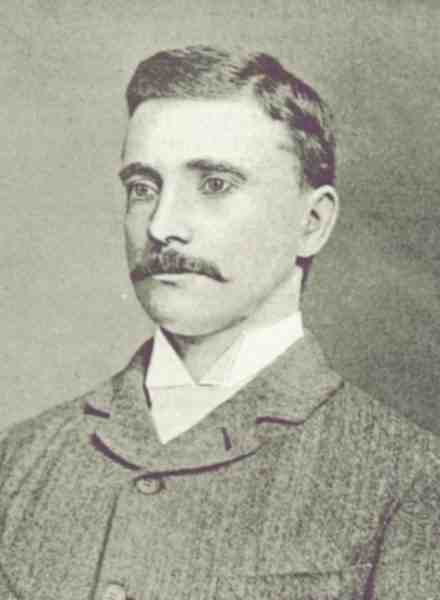
Theodore Neal
(Photo from
'Where to Buy at
Yeovil' 1891)
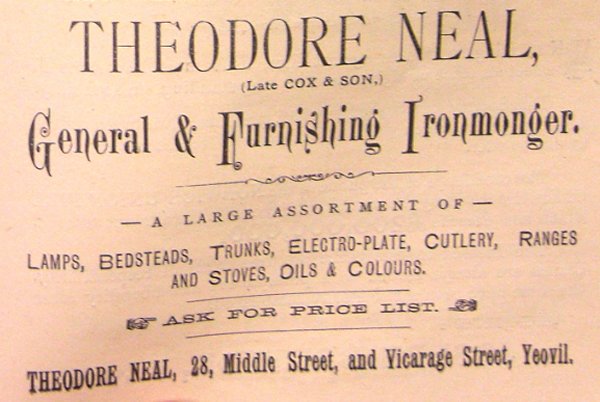
Theodore Neal's quarter-page advertisement in the 1889 edition of Whitby's Yeovil Almanack Advertiser.
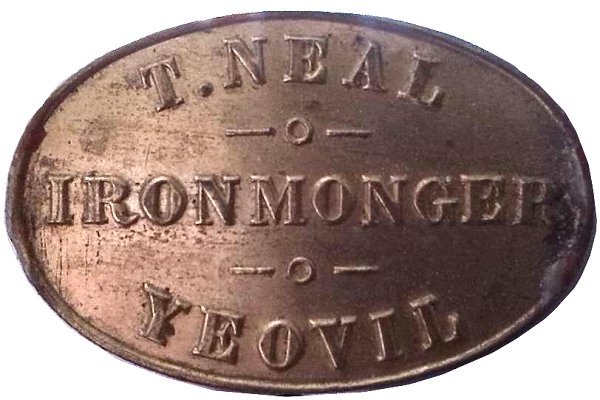
Courtesy of Pip
Davey
A brass label from a steel trunk sold by Theodore Neal. The label must date to around 1889 when he started his Yeovil ironmongery business but before the early 1890s when he went into partnership with Charles Williams. The label measures 45mm x 30mm (1¾" x 1¼") and was fixed inside the lid of the trunk with a blob of solder.
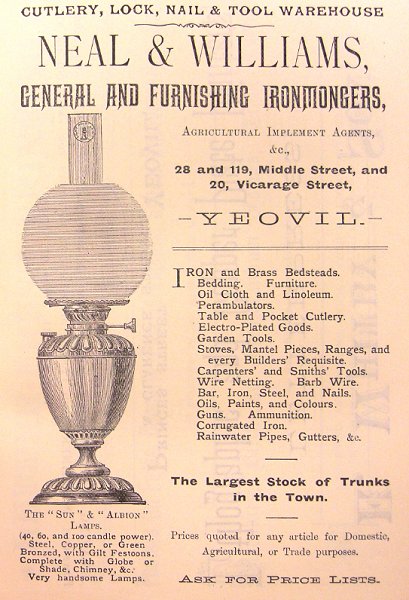
From 1892 and for the next several years this whole-page Neal & Williams advertisement appeared in Whitby's Yeovil Almanack Advertiser. Note that the addresses now includes 119 Middle Street.
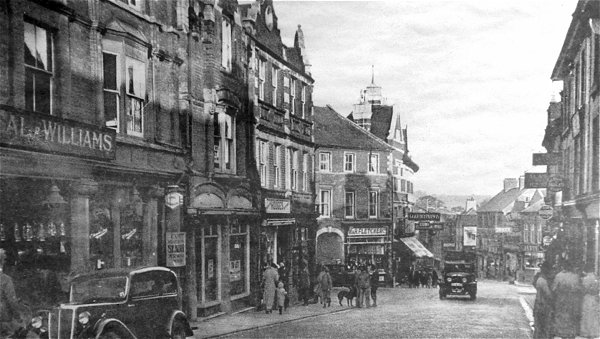
Courtesy of the
Western Gazette
This photograph dates to around 1938. Looking east along Middle Street, the truck right of centre is in the Triangle and Vicarage Street joins Middle Street where the arch is seen at centre. At extreme left is Neal & Williams' 26 Middle Street store. Charles and Emily Williams were living above the shop premises in 1901.
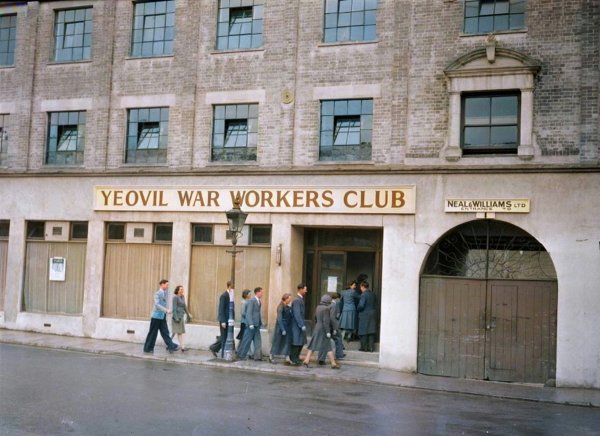
Courtesy of the
Imperial War
Museum
In a colourised photograph, a group of men and women arrive at the YWCA Yeovil War Workers' Club in 1944. The club was housed in premises in Vicarage Street, occupied by ironmongers and builders' merchants Neal & Williams Ltd, whose sign is seen above the arched doorway.
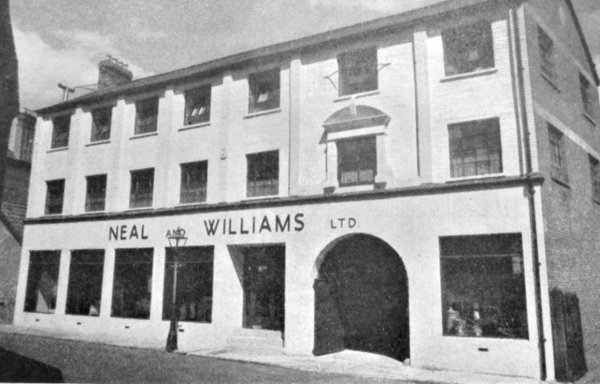
The Neal and Williams' building in Vicarage Street, photographed in the 1950s (before its facelift as seen in the photos below).
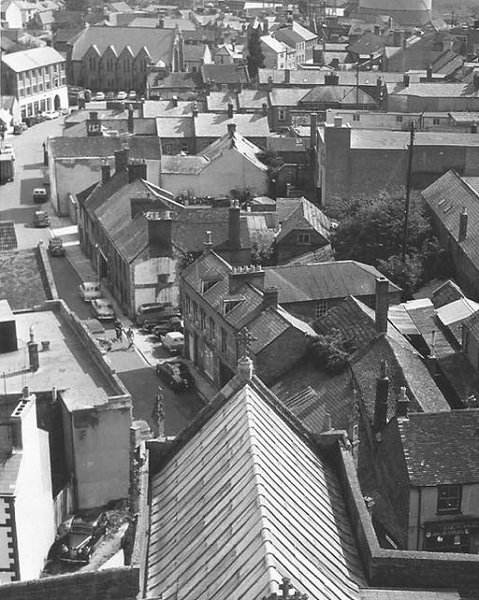
The whole of Vicarage Street as seen from the tower of St John's church in the late 1950s or early 1960s. Vicarage Street runs from its junction with Silver Street (obscured by St John's chancel roof at centre bottom) up to the premises occupied by Neal and Williams (later with a new front elevation) before veering right, in front of the Methodist church, and joining Middle Street at the Triangle at top right.
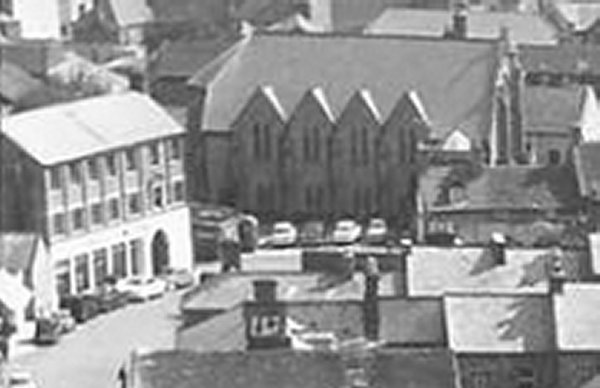
The Neal & Williams premises, at left, in an enlargement of the previous photograph.
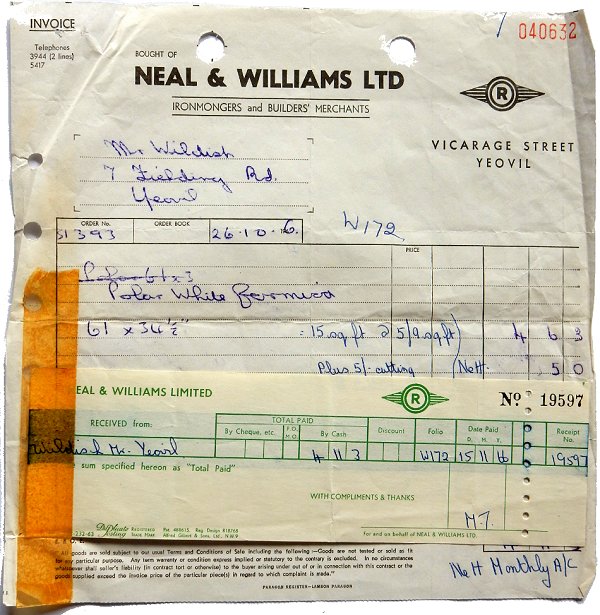
From my
collection
A receipt from Neal & Williams Ltd, dated 15 November 1966.

The Neal & Williams trademark etched into the blade of a bone-handled table knife. Made in Sheffield and distributed by Neal & Williams, most likely in the 1960s.
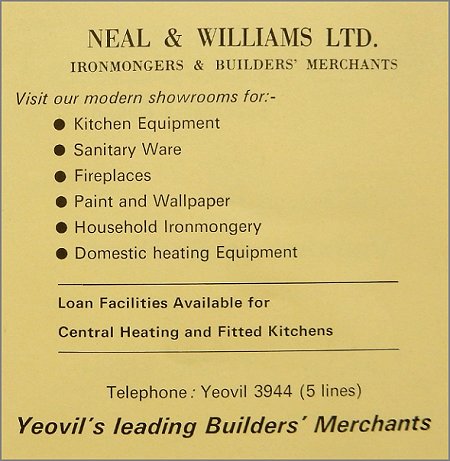
From my
collection
Neal & Williams' advertisement in the 1970 Yeovil Guide.
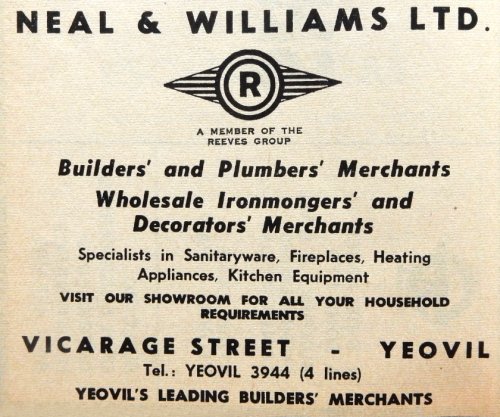
From my
collection
Neal & Williams' advertisement in the 1970 edition of Kelly's Directory indicating that at this time they were part of the Reeves Group.
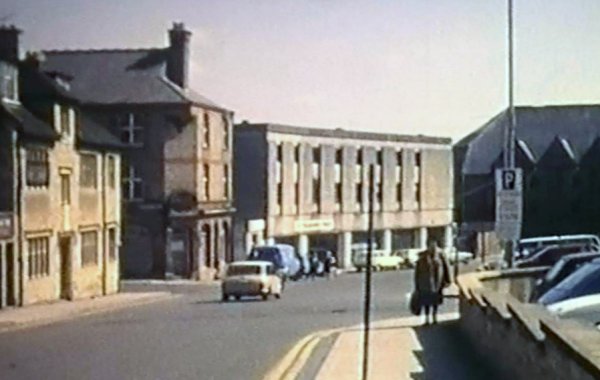
Looking eastwards towards the bend in Vicarage Street in the late 1970s - apparently re-fronted. At extreme left is the Albion Inn, then the junction of Vincent Street, on the opposite corner was the building that had been the Army & Navy Stores. The modern building at centre had been the premises of Neal & Williams Ltd. Next was the entrance to the Council's Town Yard and finally, at right, the Methodist church - the only building in this scene that remains today.
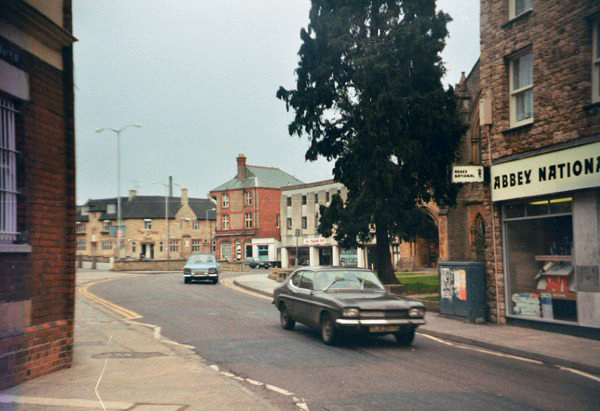
Courtesy of
Chris Rendell
Vicarage Street photographed from its junction with Middle Street in 1983. In the distance are seen the Albion Inn, the entrance to Vincent Street, the old Army and Navy building and the premises of Neal & Williams.
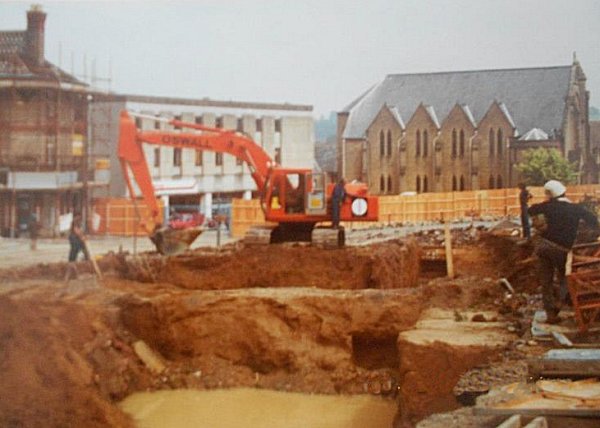
The demolition of Vicarage Street in 1983. By this time Neal & Williams had left the property seen behind the JCB.
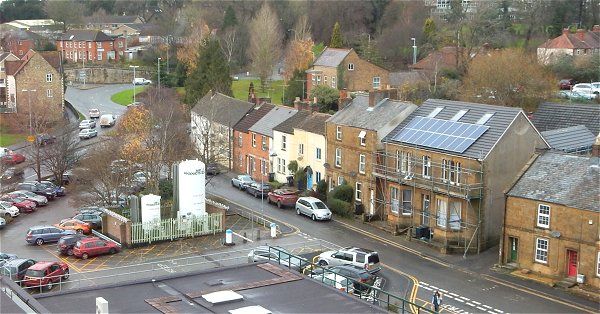
A view from the 8th floor of the hospital looking towards the Fiveways Roundabout - seen as green in the top left quadrant. Bottom left is a small car park and the flat roof of one of the single-storey hospital buildings. Running from centre to lower right are a few of the remaining pre-twentieth century buildings to survive in Higher Kingston. The scaffolded building is Richmond Villa, built between 1858 and 1886 and the home of Charles Williams in 1911. Photographed in 2014.